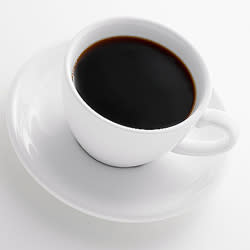How to brew the perfect cup of coffee

By Trystan L. Bass
More from Green Picks blog
You've probably heard of the "latte factor" - by spending $2.50 on coffee at a cafe every day, you're wasting money that could have added up to millions. If you subscribe to this theory, you try making coffee at home. But an ordinary cup of joe doesn't always satisfy.
Do you have to spend thousands on a fancy espresso machine or buy the most expensive coffee beans? That would defeat idea of saving money by brewing coffee at home.
We looked for expert advice on how to make great coffee and discovered that freshness is more important than fancy equipment or ingredients.
Consumer Reports finds that most brands of automatic-drip coffeemakers will brew a decent cup of coffee. The main differences are extra features such as timers, thermal carafes, and such. Choose the coffeemaker that fits your price range and kitchen style.
Many coffee aficionados prefer manual-pour coffeemakers because they draw out more complex flavors from the coffee grinds. On Epicurious.com, champion barista Mike Phillips explains how to use the French press, CafeSolo, Chemex, and siphon (or vacuum) coffeemakers.
But no matter what kind of mechanism you use, the keys to brewing a great cup of coffee are actually quite simple. According to Ken Davids, editor of Coffee Review, it boils down to these steps:
Buy top quality coffee.
Use clean, odor-free, but not distilled water.
Keep coffee hot after brewing in a thermal carafe.
If you have good coffee beans, clean water, and keep the coffee hot, you'll be on your way to beating the daily grind of paying $2.50 per cup.
To get quality coffee, start by avoiding any of the canned grounds. Says Davids: "American canned supermarket coffees consist mainly of the lowest quality robusta beans that have been steamed to neutralize the foul flavors created by drying the coffee fruit in decaying, putrid piles. So they come across as neutral, empty tasting brown water." A better bet is whole beans from a company like Green Mountain Coffee, Peet's Coffee and Tea, or even Starbucks (16 ounces of beans costs $10.95 at a Startbucks store and lasts a lot longer than that one $2.50 latte!).
If you don't like the taste of your tap water, get a filter for your house, faucet, or pitcher. The Environmental Protection Agency regularly tests U.S. tap water for safety, so there's no real need to use bottled water. But if local plumbing or minerals affect the flavor, a filter is the best bet for general drinking and especially for coffee brewing.
Food Network's Alton Brown has a handy video showing how to get the most out of an automatic-drip coffeemaker. You'll want to add 2 tablespoons of coffee grounds and 6 ounces of water for each cup of coffee desired, regardless of what the machine might instruct. After all, it's only a machine.
Finally, make sure to take the coffee pot off the heating element when it's finished brewing, if you're using an automatic-drip coffeemaker. When the pot sits on the heat, the coffee will get burnt. To keep it warm, transfer the coffee into a thermal carafe. This simple step makes sure that the last cup out of the pot tastes as good as the first one. Some models of coffeemakers brew directly into a thermal carafe - if you're upgrading, this is something to consider.
And if you want a touch of that latte experience without an espresso machine, just heat up some milk and whip it with a battery-powered milk frother. You'll only have to use it for a few weeks to recoup the investment versus those individual lattes.
